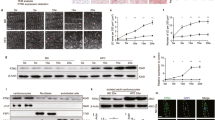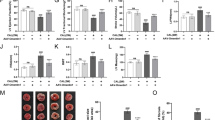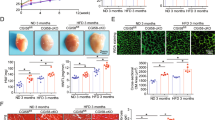Abstract
The sirtuin 6 (SIRT6) participates in regulating glucose and lipid homeostasis. However, the function of SIRT6 in the process of cardiac pathogenesis caused by obesity-associated lipotoxicity remains to be unveiled. This study was designed to elucidate the role of SIRT6 in the pathogenesis of cardiac injury due to nutrition overload-induced obesity and explore the downstream signaling pathways affecting oxidative stress in the heart. In this study, we used Sirt6 cardiac-specific knockout murine models treated with a high-fat diet (HFD) feeding to explore the function and mechanism of SIRT6 in the heart tissue during HFD-induced obesity. We also took advantage of neonatal cardiomyocytes to study the role and downstream molecules of SIRT6 during HFD-induced injury in vitro, in which intracellular oxidative stress and mitochondrial content were assessed. We observed that during HFD-induced obesity, Sirt6 loss-of-function aggravated cardiac injury including left ventricular hypertrophy and lipid accumulation. Our results evidenced that upon increased fatty acid uptake, SIRT6 positively regulated the expression of endonuclease G (ENDOG), which is a mitochondrial-resident molecule that plays an important role in mitochondrial biogenesis and redox homeostasis. Our results also showed that SIRT6 positively regulated superoxide dismutase 2 (SOD2) expression post-transcriptionally via ENDOG. Our study gives a new sight into SIRT6 beneficial role in mitochondrial biogenesis of cardiomyocytes. Our data also show that SIRT6 is required to reduce intracellular oxidative stress in the heart triggered by high-fat diet-induced obesity, involving the control of ENDOG/SOD2.






Similar content being viewed by others
Data availability
Not applicable.
Code availability
Not applicable.
Abbreviations
- HFD:
-
High-fat diet
- SIRT6:
-
Sirtuin 6
- ENDOG:
-
Endonuclease G
- SOD2:
-
Superoxide dismutase 2
- CVD:
-
Cardiovascular disease
- T2DM:
-
Diabetes mellitus type 2
- SIRTs:
-
Sirtuins
- HDACs:
-
Histone deacetylases
- NAD:
-
Nicotinamide adenine dinucleotide
- IGF:
-
Insulin-like growth factor
- HCM:
-
Hypertrophic cardiomyopathy
- I/R:
-
Ischemia/reperfusion
- HW/TL:
-
Heart weight/tibial length
- WT:
-
Wild type
- LV mass:
-
Left ventricular mass
- NRCMs:
-
Neonatal rat cardiomyocytes
- SDH:
-
Succinyl dehydrogenase
- COX IV:
-
Complex IV
- cKO:
-
Cardiac-specific knockout
- LVPW:
-
Left ventricular posterior wall
- LVID:
-
Left ventricular interior diameter
- HE:
-
Hematoxylin and eosin
- ND:
-
Normal diet
- ACC:
-
Acetyl coenzyme a carboxylase
- p-ACC:
-
Phosphorylation of ACC
- CPT-1A:
-
Carnitine palmitoyl transferase 1A
- ATP:
-
Adenosine triphosphate
- ROS:
-
Reactive oxygen species
- DHE:
-
Dihydroethidium
- MOMP:
-
Mitochondrial membrane potential
- 8-OHdG:
-
8-Hydroxy-2 deoxyguanosine
- OA:
-
Oleic acid
- PA:
-
Palmitate acid
- NaB:
-
Sodium butyrate
- A. U.:
-
Arbitrary units
References
Bhatti JS, Bhatti GK, Reddy PH. Mitochondrial dysfunction and oxidative stress in metabolic disorders - a step towards mitochondria based therapeutic strategies. Biochim Biophys Acta Mol Basis Dis. 2017;1863(5):1066–77.
Blasco N, Camara Y, Nunez E, Bea A, Bares G, Forne C, Ruiz-Meana M, Giron C, Barba I, Garcia-Arumi E, Garcia-Dorado D, Vazquez J, Marti R, Llovera M, Sanchis D. Cardiomyocyte hypertrophy induced by Endonuclease G deficiency requires reactive oxygen radicals accumulation and is inhibitable by the micropeptide humanin. Redox Biol. 2018;16:146–56.
Brown DI, Griendling KK. Regulation of signal transduction by reactive oxygen species in the cardiovascular system. Circ Res. 2015;116(3):531–49.
Cardoso AC, Lam NT, Savla JJ, Nakada Y, Pereira AHM, Elnwasany A, Menendez-Montes I, Ensley EL, Petric UB, Sharma G, Sherry AD, Malloy CR, Khemtong C, Kinter MT, Tan WLW, Anene-Nzelu CG, Foo RS, Nguyen NUN, Li S, Ahmed MS, Elhelaly WM, Abdisalaam S, Asaithamby A, Xing C, Kanchwala M, Vale G, Eckert KM, Mitsche MA, McDonald JG, Hill JA, Huang L, Shaul PW, Szweda LI, Sadek HA (2020) Mitochondrial Substrate Utilization Regulates Cardiomyocyte Cell Cycle Progression. Nat Metab 2(2):167–178.
Chen D, Chen F, Xu Y, Zhang Y, Li Z, Zhang H, Pan T, Su Y, Wan M, Wang X, Ye J. AKT2 deficiency induces retardation of myocyte development through EndoG-MEF2A signaling in mouse heart. Biochem Biophys Res Commun. 2017a;493(4):1410–7.
Chen F, Chen D, Zhang Y, Jin L, Zhang H, Wan M, Pan T, Wang X, Su Y, Xu Y, Ye J. Interleukin-6 deficiency attenuates angiotensin II-induced cardiac pathogenesis with increased myocyte hypertrophy. Biochem Biophys Res Commun. 2017b;494(3–4):534–41.
Chen D, Li Z, Bao P, Chen M, Zhang M, Yan F, Xu Y, Ji C, Hu X, Sanchis D, Zhang Y, Ye J. Nrf2 deficiency aggravates Angiotensin II-induced cardiac injury by increasing hypertrophy and enhancing IL-6/STAT3-dependent inflammation. Biochim Biophys Acta Mol Basis Dis. 2019;1865(6):1253–64.
Dan Dunn J, Alvarez LA, Zhang X, Soldati T. Reactive oxygen species and mitochondria: a nexus of cellular homeostasis. Redox Biol. 2015;6:472–85.
Gonzalez-Muniesa P, Martinez-Gonzalez MA, Hu FB, Despres JP, Matsuzawa Y, Loos RJF, Moreno LA, Bray GA, Martinez JA. Obesity. Nat Rev Dis Primers. 2017;3:17034.
Graille M, Wild P, Sauvain JJ, Hemmendinger M, Guseva Canu I, Hopf NB. Urinary 8-OHdG as a biomarker for oxidative stress: a systematic literature review and meta-analysis. Int J Mol Sci. 2020;21(11):3743.
Griendling KK, Touyz RM, Zweier JL, Dikalov S, Chilian W, Chen Y-R, Harrison DG, Bhatnagar A. Measurement of Reactive Oxygen Species, Reactive Nitrogen Species, and Redox-Dependent Signaling in the Cardiovascular System. Circ Res. 2016;119(5). https://doi.org/10.1161/RES.0000000000000110.
Grootaert MOJ, Finigan A, Figg NL, Uryga AK, Bennett MR. SIRT6 Protects Smooth Muscle Cells From Senescence and Reduces Atherosclerosis. Circ Res. 2021;128(4):474–91. https://doi.org/10.1161/CIRCRESAHA.120.318353.
Kanfi Y, Peshti V, Gil R, Naiman S, Nahum L, Levin E, Kronfeld-Schor N, Cohen HY. SIRT6 protects against pathological damage caused by diet-induced obesity. Aging Cell. 2010;9(2):162–73.
Kanwal A, Pillai VB, Samant S, Gupta M, Gupta MP. The nuclear and mitochondrial sirtuins, Sirt6 and Sirt3, regulate each other’s activity and protect the heart from developing obesity-mediated diabetic cardiomyopathy. FASEB J. 2019;33(10):10872–88.
Kida Y, Goligorsky MS. Sirtuins, cell senescence, and vascular aging. Can J Cardiol. 2016;32(5):634–41.
Kilbride SM, Prehn JH. Central roles of apoptotic proteins in mitochondrial function. Oncogene. 2013;32(22):2703–11.
Kim HS, Xiao C, Wang RH, Lahusen T, Xu X, Vassilopoulos A, Vazquez-Ortiz G, Jeong WI, Park O, Ki SH, Gao B, Deng CX. Hepatic-specific disruption of SIRT6 in mice results in fatty liver formation due to enhanced glycolysis and triglyceride synthesis. Cell Metab. 2010;12(3):224–36.
Kozako T, Suzuki T, Yoshimitsu M, Uchida Y, Kuroki A, Aikawa A, Honda S, Arima N, Soeda S. Novel small-molecule SIRT1 inhibitors induce cell death in adult T-cell leukaemia cells. Sci Rep. 2015;5:11345.
Kuang J, Zhang Y, Liu Q, Shen J, Pu S, Cheng S, Chen L, Li H, Wu T, Li R, Li Y, Zou M, Zhang Z, Jiang W, Xu G, Qu A, Xie W, He J. Fat-specific Sirt6 ablation sensitizes mice to high-fat diet-induced obesity and insulin resistance by inhibiting lipolysis. Diabetes. 2017;66(5):1159–71.
Kuang J, Chen L, Tang Q, Zhang J, Li Y, He J. The role of Sirt6 in obesity and diabetes. Front Physiol. 2018;9:135.
Lim GB. Inhibiting fatty acid oxidation promotes cardiomyocyte proliferation. Nature Rev Cardiol. 2020;17(5):266–7. https://doi.org/10.1038/s41569-020-0361-4.
Lin JLJ, Nakagawa A, Skeen-Gaar R, Yang WZ, Zhao P, Zhang Z, Ge X, Mitani S, Xue D, Yuan HS. Oxidative stress impairs cell death by repressing the nuclease activity of mitochondrial endonuclease G. Cell Rep. 2016;16(2):279–87.
Loch T, Vakhrusheva O, Piotrowska I, Ziolkowski W, Ebelt H, Braun T, Bober E. Different extent of cardiac malfunction and resistance to oxidative stress in heterozygous and homozygous manganese-dependent superoxide dismutase-mutant mice. Cardiovasc Res. 2009;82(3):448–57.
McDermott-Roe C, Ye J, Ahmed R, Sun XM, Serafin A, Ware J, Bottolo L, Muckett P, Canas X, Zhang J, Rowe GC, Buchan R, Lu H, Braithwaite A, Mancini M, Hauton D, Marti R, Garcia-Arumi E, Hubner N, Jacob H, Serikawa T, Zidek V, Papousek F, Kolar F, Cardona M, Ruiz-Meana M, Garcia-Dorado D, Comella JX, Felkin LE, Barton PJ, Arany Z, Pravenec M, Petretto E, Sanchis D, Cook SA. Endonuclease G is a novel determinant of cardiac hypertrophy and mitochondrial function. Nature. 2011;478(7367):114–8.
Miao L, St Clair DK. Regulation of superoxide dismutase genes: implications in disease. Free Radic Biol Med. 2009;47(4):344–56.
Michan S, Sinclair D. Sirtuins in mammals: insights into their biological function. Biochem J. 2007;404(1):1–13.
Murphy MP. How mitochondria produce reactive oxygen species. Biochem J. 2009;417(1):1–13.
Ohta Y, Kinugawa S, Matsushima S, Ono T, Sobirin MA, Inoue N, Yokota T, Hirabayashi K, Tsutsui H. Oxidative stress impairs insulin signal in skeletal muscle and causes insulin resistance in postinfarct heart failure. Am J Physiol Heart Circ Physiol. 2011;300(5):H1637-1644.
Peng L, Qian M, Liu Z, Tang X, Sun J, Jiang Y, Sun S, Cao X, Pang Q, Liu B. Deacetylase-independent function of SIRT6 couples GATA4 transcription factor and epigenetic activation against cardiomyocyte apoptosis. Nucl Acids Res. 2020;48(9):4992–5005. https://doi.org/10.1093/nar/gkaa214.
Powell-Wiley TM, Poirier P, Burke LE, Després J-P, Gordon-Larsen P, Lavie CJ, Lear SA, Ndumele CE, Neeland IJ, Sanders P, St-Onge M-P. Obesity and Cardiovascular Disease: A Scientific Statement From the American Heart Association. Circulation. 2021;143(21). https://doi.org/10.1161/CIR.0000000000000973.
Schwer B, Schumacher B, Lombard DB, Xiao C, Kurtev MV, Gao J, Schneider JI, Chai H, Bronson RT, Tsai LH, Deng CX, Alt FW. Neural sirtuin 6 (Sirt6) ablation attenuates somatic growth and causes obesity. Proc Natl Acad Sci U S A. 2010;107(50):21790–4.
Seravalle G, Grassi G. Obesity and hypertension. Pharmacol Res. 2017;122:1–7.
Sletten AC, Peterson LR, Schaffer JE. Manifestations and mechanisms of myocardial lipotoxicity in obesity. J Intern Med. 2018;284(5):478–91.
Strub T, Ghiraldini FG, Carcamo S, Li M, Wroblewska A, Singh R, Goldberg MS, Hasson D, Wang Z, Gallagher SJ, Hersey P, Ma’ayan A, Long GV, Scolyer RA, Brown B, Zheng B, Bernstein E. SIRT6 haploinsufficiency induces BRAFV600E melanoma cell resistance to MAPK inhibitors via IGF signalling. Nature Commun. 2018;9(1). https://doi.org/10.1038/s41467-018-05966-z.
Sun Y, Zhou K, He M, Gao Y, Zhang D, Bai Y, Lai Y, Liu M, Han X, Xu S, Tian W, Xu J. The effects of different fluorescent indicators in observing the changes of the mitochondrial membrane potential during oxidative stress-induced mitochondrial injury of cardiac H9c2 cells. J Fluoresc. 2020;30(6):1421–30.
Sundaresan NR, Vasudevan P, Zhong L, Kim G, Samant S, Parekh V, Pillai VB, Ravindra PV, Gupta M, Jeevanandam V, Cunningham JM, Deng CX, Lombard DB, Mostoslavsky R, Gupta MP. The sirtuin SIRT6 blocks IGF-Akt signaling and development of cardiac hypertrophy by targeting c-Jun. Nat Med. 2012;18(11):1643–50.
van der Vusse GJ, Glatz JF, Stam HC, Reneman RS. Fatty acid homeostasis in the normoxic and ischemic heart. Physiol Rev. 1992;72(4):881–940.
von Haehling S, Doehner W, Anker SD. Obesity and the heart a weighty issue. J Am Coll Cardiol. 2006;47(11):2274–6.
Wang XX, Wang XL, Tong MM, Gan L, Chen H, Wu SS, Chen JX, Li RL, Wu Y, Zhang HY, Zhu Y, Li YX, He JH, Wang M, Jiang W. SIRT6 protects cardiomyocytes against ischemia/reperfusion injury by augmenting FoxO3alpha-dependent antioxidant defense mechanisms. Basic Res Cardiol. 2016;111(2):13.
Wang W, Li J, Tan J, Wang M, Yang J, Zhang ZM, Li C, Basnakian AG, Tang HW, Perrimon N, Zhou Q. Endonuclease G promotes autophagy by suppressing mTOR signaling and activating the DNA damage response. Nat Commun. 2021;12(1):476.
Webster KA. A sirtuin link between metabolism and heart disease. Nat Med. 2012;18(11):1617–9.
Williams EP, Mesidor M, Winters K, Dubbert PM, Wyatt SB. Overweight and obesity: prevalence, consequences, and causes of a growing public health problem. Curr Obes Rep. 2015;4(3):363–70.
Yang M, Linn BS, Zhang Y, Ren J. Mitophagy and mitochondrial integrity in cardiac ischemia-reperfusion injury. Biochim Biophys Acta Mol Basis Dis. 2019;1865(9):2293–302.
Ye J, Cardona M, Llovera M, Comella JX, Sanchis D. Translation of Myocyte Enhancer Factor-2 is induced by hypertrophic stimuli in cardiomyocytes through a Calcineurin-dependent pathway. J Mol Cell Cardiol. 2012;53(4):578–87.
Yu SS, Cai Y, Ye JT, Pi RB, Chen SR, Liu PQ, Shen XY, Ji Y. Sirtuin 6 protects cardiomyocytes from hypertrophy in vitro via inhibition of NF-kappaB-dependent transcriptional activity. Br J Pharmacol. 2013;168(1):117–28.
Zhao X, Liu L, Li R, Wei X, Luan W, Liu P, Zhao J. Hypoxia-inducible factor 1-alpha (HIF-1alpha) induces apoptosis of human uterosacral ligament fibroblasts through the death receptor and mitochondrial pathways. Med Sci Monit. 2018;24:8722–33.
Acknowledgements
Not applicable.
Funding
This work was supported by the Natural Science Foundation of Jiangsu Province (Grant No. BK20191324); “Double First-Class” University project (Grant No. CPU2018GY09); National undergraduate innovation and entrepreneurship training program (Grant No. 202010316164, 201910316009G, 3151910148, 202010316192); the Fundamental Research Funds for the Central Universities (Grant No. 2632020YX01); The Open Project of State Key Laboratory of Natural Medicines (Grant No. SKLNMKF202102); Ministerio de Ciencia e Innovación, Gobierno de España (Grant No. PID2019-104509RB-I00); and A Project Funded by the Priority Academic Program Development of Jiangsu Higher Education Institutions (PAPD).
Author information
Authors and Affiliations
Contributions
Shuya Gao, Qingchen Yang, and Yue Peng did most of the experimental work and data analysis. Weixian Kong, Zekun Liu, Zhe Li, Jiawen Chen, Mengmeng Bao, Xie Li, Hanwen Zhang, YueXin Zhang, Yubin Zhang, Xiaohong Bian, and Liang Jin provided technical support. Junmei Ye, Fangrong Yan, and Daniel Sanchis conceived and designed the experiments. Junmei Ye drafted the article. Daniel Sanchis and Fangrong Yan revised the manuscript and gave fundamental suggestions.
Corresponding authors
Ethics declarations
Competing interests
The authors declare no competing interests.
Ethics approval
The investigation with experimental animals conforms to the Guide for the Care and Use of Laboratory Animals published by the China Pharmaceutical University (No. 2021–12-013) and was evaluated and approved by the Experimental Animal Ethic Committee of China Pharmaceutical University. Healthy human heart sample and heart sample from patients with heart failure were from West China Hospital (No. 2019546), and all the hearts are from male donates.
Consent to participate
Not applicable.
Conflict of interest
The authors declare no competing interests.
Additional information
Publisher's Note
Springer Nature remains neutral with regard to jurisdictional claims in published maps and institutional affiliations.
Supplementary Information
Below is the link to the electronic supplementary material.
Rights and permissions
About this article
Cite this article
Gao, S., Yang, Q., Peng, Y. et al. SIRT6 regulates obesity-induced oxidative stress via ENDOG/SOD2 signaling in the heart. Cell Biol Toxicol 39, 1489–1507 (2023). https://doi.org/10.1007/s10565-022-09735-z
Received:
Accepted:
Published:
Issue Date:
DOI: https://doi.org/10.1007/s10565-022-09735-z




